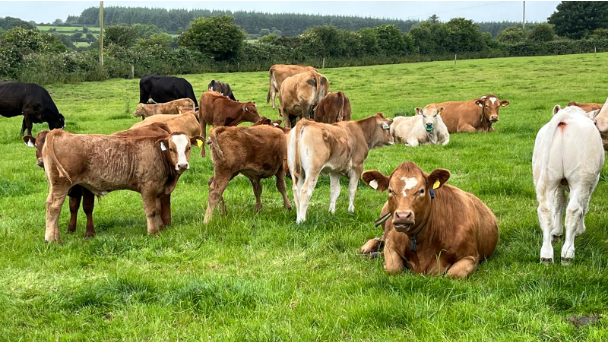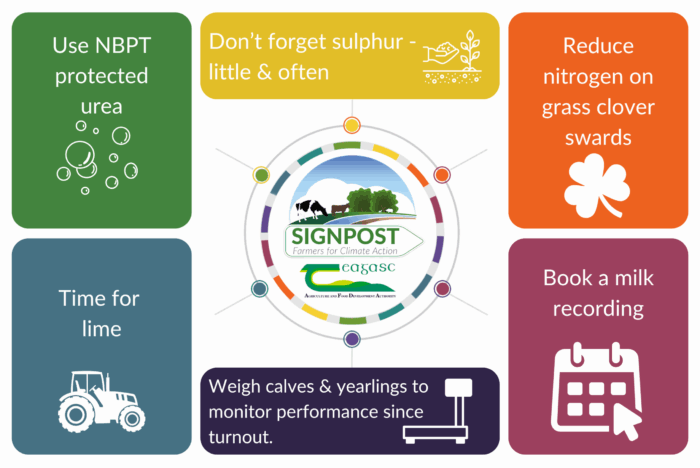Bull finishing and winter feed on the McCarthys’ Future Beef farm

Father and son team Eamon and Donnchadh McCarthy are participants in the Teagasc Future Beef and Signpost Programmes. Here, Eamon McCarthy takes us through bull performance, grassland management and breeding performance.
Participants in the Future Beef Programme, we run a suckler to beef enterprise, split into spring (60%) and autumn (40%) calving, consisting of 55 suckler cows. The males are finished as under 16-month bull beef, while the heifers, not retained for breeding, are finished at 18-20 months. Own heifers are kept for breeding.
Bull performance
The first half of the bulls finished at under 16 months averaged 432kg at 15.5 months of age and graded U+3-. We are very happy with their performance so far. The remaining bulls are performing well and were weighed recently. The first half of the bulls sold were mainly by terminal Charolais sires. The remaining bulls were sired by more maternal type Limousin, Simmental and Saler bulls.
The autumn born bulls are currently outside on grass and these animals will be housed in the next month or so for finishing. We have had a few isolated cases of viral pneumonia in this group and, as a result, we will vaccinate the group in line with veterinary advice. The plan is to vaccinate the weanlings for viral pneumonia this year in advance of weaning from August.
Winter feed
The second-cut silage, after growing for 40 days and receiving 80 units/ac of nitrogen, will be cut, allowing us to meet the needs of our fodder budget. We need 750 bales for a five-month winter.
The majority of the silage made to date will be 70+DMD and we may let a proportion of the second cut bulk up, which can be fed to dry suckler cows over the winter period.
Just from examining the grains, the winter barley looks like a good crop. The plan is to return this ground to grass post-harvest. Ground currently under grass will be sown with winter barley instead. The barley is harvested below 18% dry matter and stored in a loft for feeding to finishing bulls and heifers over the winter and spring period. The loft has a timber floor and a large surface area, meaning the barley isn’t stacked high. The barley is transferred to the loft from the trailer using an auger. Once the barley is harvested as dry as possible, we have never had an issue with heating.
Grassland management and reseeds
Our farm cover was 761kg DM/ha on the 23rd of June, the demand was 52kg DM/ha/day and the growth was lower at 41kg DM/ha/day. The spring-calving cows had one more cover of 1,400kg DM/ha left to graze before grazing covers of 1,000kg DM/ha. Over the last rotation, all of the paddocks were topped with a mower which is now probably impacting grass growth and resulting in a flat wedge. The paddocks will receive half a bag of 38% protected urea over the next week, and we hope grass growth will improve. The stocking rate is 2.93LU/ha. Needless to say, we will walk the farm and make a decision based on the result.
The newly reseeded field is within a week of grazing, and we are very happy with the take of clover. The reseed has received its post emergence clover safe herbicide. The plan is to graze this paddock with the spring calving suckler herd within the next week. Overall, we are happy with how the reseed turned out, although we probably underestimated how long the paddock was out of the rotation. However, we hope to get increased grass growth rate from this field at the shoulders of the year when it’s wanted most.
Breeding update on the Future Beef farm
The breeding season was completed after seven weeks of artificial insemination. We normally breed over six weeks. However, we noticed two heifers repeating in week seven and, as a result, an exception was made to extend by a week. We are happy with how it went, and the heifers can now be moved to the out-block which will allow us to bring the autumn calvers home in preparation for calving.
Eamon and Donnchadh farm in Carrigeen, Glendine, Youghal, Co. Waterford and are part of the Teagasc Future Beef Programme with the Signpost Programme.
The above article first appeared in the Farming Examiner as part of a Signpost Programme update.
Climate Actions for July
Each month, the Teagasc Signpost Programme promotes six key actions for each months. This month’s actions are:
- Use NBPT protected urea,
- Don’t forget sulphur – little and often,
- Reduce nitrogen on grass clover swards,
- Book a milk recording,
- Weigh calves and yearlings to monitor performance since turnout,
- Apply lime.

